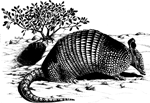Vertebrate Pest Conference: Proceedings

Vertebrate Pest Conference Proceedings: 9th (1980)
Date of this Version
March 1980
Document Type
Article
Abstract
In laboratory tests with adult coyotes (Canis latrans) a pyrotechnic fumigant containing two active ingredients, sodium nitrate and charcoal, was found to be just as effective as the U.S. Fish and Wildlife Service Gas Cartridge that contains six active and two inactive ingredients. The two-ingredient cartridge produces high concentrations of carbon monoxide. Field tests with cartridges containing 240 g of 65% sodium nitrate and 35% charcoal produced a 96% mortality rate in coyote pups. A cartridge containing 65 g of 65% sodium nitrate and 35% charcoal was effective in both laboratory and field tests on wild Norway rats (Rattus norvegicus). In field tests conducted at a rat-infested cattle feedlot, there was a 77% average (35% to 95% range) reduction in numbers of reopened burrows after fumigation as compared to pretreatment figures. Sodium nitrate and charcoal are not dangerous chemicals. The acute oral LD5Q for both sodium nitrate and charcoal is greater than 3,000 mg/kg in rats, and there was no potentiation when given in combination at 3,000 mg/kg. No signs of secondary toxicity were observed in bobcats (Lynx rufus) fed rats killed by fumes from burning sodium nitrate and charcoal. Since gas cartridges are used underground, potential hazards to humans and the environment are nil. When the cartridges are used properly they are effective devices for controlling vertebrate pests such as coyotes and rats.

